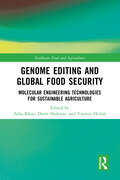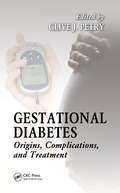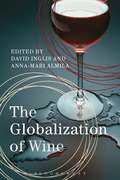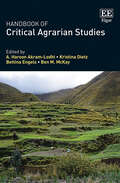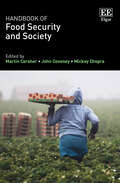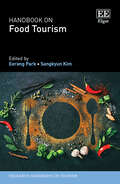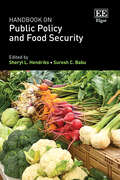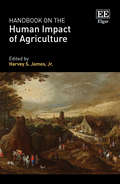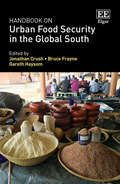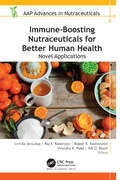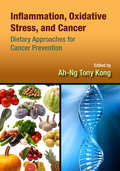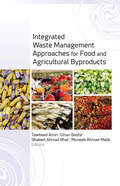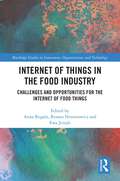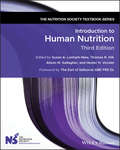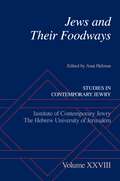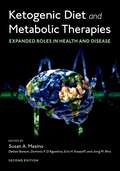- Table View
- List View
Genome Editing and Global Food Security: Molecular Engineering Technologies for Sustainable Agriculture (Earthscan Food and Agriculture)
With the rapid increase in the global population and changing climatic impacts on agriculture, this book demonstrates how genome editing will be an indispensable technique to overcome ongoing and prospective agricultural challenges. This book examines the role of genome editing in improving crop yields and contributing to global food security. It summarizes a range of genome editing techniques and discusses the roles they can play in producing a new generation of high-yielding, climate-ready crops. This includes site-specific nucleases, precision genome engineering, clustered regularly interspaced short palindromic repeats, and bioinformatics. It showcases how these gene editing techniques can tailor plants to not only increase yield-related traits but to also make them better suited to their environment and to be resistant to pests and extreme climatic events, such as droughts. The book also examines genome editing regulations and policies, the commercialization of genome-edited crops, and biosafety and biosecurity concerns. Overall, this book reveals and showcases how genome editing can improve crop resilience and production to address current and future agricultural challenges and alleviation of global food security concerns. This book will be of great interest to students and scholars of agricultural science, crop and plant science, genome editing, sustainable agriculture, biotechnology, and food security.
Gestational Diabetes: Origins, Complications, and Treatment
Given the rapid increase in the worldwide incidence of gestational diabetes, the need for defining the risks and effects associated with raised glucose concentrations in pregnancy is great. Recent large studies are helping to define the risks, as well as identify the benefits of reducing glucose intolerance. Written by an esteemed list of internati
Global Brooklyn: Designing Food Experiences in World Cities
What do the fashionable food hot spots of Cape Town, Mumbai, Copenhagen, Rio de Janeiro, and Tel Aviv have in common? Despite all their differences, consumers in each major city are drawn to a similar atmosphere: rough wooden tables in postindustrial interiors lit by edison bulbs. There, they enjoy single-origin coffee, kombucha, and artisanal bread. This is 'Global Brooklyn,' a new transnational aesthetic regime of urban consumption. It may look shabby and improvised, but it is all carefully designed. It may romance the analog, but is made to be Instagrammed. It often references the New York borough, but is shaped by many networked locations where consumers participate in the global circulation of styles, flavors, practices, and values. This book follows this phenomenon across different world cities, arguing for a stronger appreciation of design and materialities in understanding food cultures. Attentive to local contexts, struggles, and identities, contributors explore the global mobility of aesthetic, ethical, and entrepreneurial projects, and how they materialize in everyday practices on the ground. They describe new connections among eating, drinking, design, and communication in order to give a clearer sense of the contemporary transformations of food cultures around the world.
The Globalization of Wine
The Globalization of Wine is a one-stop guide to understanding wine across the world today. Examining a broad range of developments in the wine world, it considers the social, cultural, economic, political and geographical dimensions of wine globalization. It investigates how large-scale changes in production, distribution and consumption are transforming the wine that we drink. Comprehensive background discussion is complemented by vivid case study chapters from a variety of international contributors. Many different countries and regions are covered, including China, the USA and Hong Kong, as are key themes, debates and controversies in contemporary wine worlds. Innovative, up-to-date and interdisciplinary, The Globalization of Wine illustrates the diversity and complexity of wine globalization processes across the planet, both in the past and at the present time. It is essential reading for academics and students in food and drink studies, sociology, anthropology, globalization studies, geography and cultural studies. It also provides a jargon-free resource for wine professionals and connoisseurs.
Grapes (Large Print)
This is an image of a bunch of purple grapes shown life-sized in the middle of the page. There is a locator dot shown, which will be at the top left of the page when the image is the correct way up. At the top of the page, you can find the main stalk where the bunch of grapes has been cut from the vine. Further down the page, this branches off into the smaller stalks that the oval-shaped fruit hang from.
Grapes (UEB Contracted)
This is an image of a bunch of purple grapes shown life-sized in the middle of the page. There is a locator dot shown, which will be at the top left of the page when the image is the correct way up. At the top of the page, you can find the main stalk where the bunch of grapes has been cut from the vine. Further down the page, this branches off into the smaller stalks that the oval-shaped fruit hang from.
Grapes (UEB Uncontracted)
This is an image of a bunch of purple grapes shown life-sized in the middle of the page. There is a locator dot shown, which will be at the top left of the page when the image is the correct way up. At the top of the page, you can find the main stalk where the bunch of grapes has been cut from the vine. Further down the page, this branches off into the smaller stalks that the oval-shaped fruit hang from.
Handbook of Critical Agrarian Studies
Exploring the emerging and vibrant field of critical agrarian studies, this comprehensive Handbook offers interdisciplinary insights from both leading scholars and activists to understand agrarian life, livelihoods, formations and processes of change. It highlights the development of the field, which is characterized by theoretical and methodological pluralism and innovation. The Handbook presents critical analyses of, and examines controversies about, historical and contemporary social structures and processes in agrarian and rural settings from a wide range of perspectives. Chapters explore the origins of critical agrarian studies, the concepts underpinning the diverse theoretical approaches to the field, and the strengths and weaknesses of different methodologies used within the field. Finally, it illuminates debates around the topic and trajectories for future research and development. This will be a vital resource for graduate students, scholars and activists interested in critical agrarian studies. The analytical and empirical insights will also be helpful to students of environmental and development studies as well as agricultural and development economics, human geography and socio-cultural anthropology.
Handbook of Food Security and Society
Events such as the COVID-19 pandemic and the war in Ukraine have drawn the subject of food security firmly into the public eye. This timely Handbook examines and responds to this pertinent topic, offering calculated solutions to food insecurity. Exploring an international range of perspectives surrounding food security, the Handbook of Food Security and Society illustrates clear links between food and broader social welfare policy and economic determinants. Chapters describe histories of food security, its measurement and question the role of movements, such as charitable organisations, that have been involved in the food security debate. They resolutely locate food welfare as a fundamental human right. This comprehensive Handbook will be essential for politics, economics and social policy academics and researchers seeking to gain a clearer understanding of food security history and policy. It will additionally be beneficial to specific practitioners, such as nutritionists and policy makers, working to understand key connections between welfare strategies, wellbeing and food security.
Handbook on Food Tourism (Research Handbooks in Tourism series)
This Handbook on Food Tourism provides an overview of the past, present, and future of research traditions, perspectives, and concerns about the food tourism phenomenon. Taking a multidisciplinary approach, it contributes to the historical and anthropological understanding of the nexus between food, society, and tourism that underpins the divergent business and marketing efforts in tourism today.Expert contributors from across the globe not only explore the theoretical and conceptual foundations of food tourism research, but also address the significance of the multistakeholder nature of tourism in the context of food tourism development. Chapters present empirical research using quantitative and qualitative methods, conceptual papers and critical literature reviews employing archival research methods and informetric mapping, and analysis of secondary data from social, political, and environmental sources. Rich with information and data about diverse socio-cultural and environmental issues, this Handbook consolidates knowledge on the studies of food tourism from around the world and provides a vision for future research.Covering the breadth of food tourism research, this Handbook will be a fundamental reference work for researchers, academics, and students in tourism management, human geography, social and cultural geography, and business and management. It will similarly appeal to professionals, local authorities, and local food and tourism industries and businesses.
Handbook on Public Policy and Food Security
The Handbook on Public Policy and Food Security provides multi-disciplinary insights into food security analysis across the Sustainable Development Goals (SDGs). As food security is an essential outcome and a part of sustainable and healthy food systems, this Handbook addresses the urgent need to provide a comprehensive overview of the field’s current developments.Paired chapters focuses on a specific SDG in turn, presenting an overview and using qualitative and quantitative methodological approaches to assess the impact of food security on the attainment of the specific goal, and the evaluation of the impact of the goal on food security. This Handbook brings together experts in the field who advocate for a food systems approach, highlighting how various components of a food system function together to achieve the goal of food security for all. The cross-policy themes covered extend beyond the SDGs, proving relevant for public policy and food security in the foreseeable future. This erudite Handbook will be highly informative for academics, researchers and students in agricultural economics, development studies, human geography, human rights and comparative social policy. It will also be beneficial for professionals working in public policy, NGOs and multilateral organisations who are interested in understanding food security and nutrition monitoring.
Handbook on the Human Impact of Agriculture
This timely Handbook synthesizes and analyzes key issues and concerns relating to the impact of agriculture on both farmers and non-farmers. With a unique focus on humans rather than animals or the environment, the book is interdisciplinary and international in scope, with contributions from sociologists, economists, anthropologists and geographers providing case studies and examples from all six populated continents.Looking at the pervasive impact of agriculture, the Handbook explores all aspects of the production of food and fiber within the agrifood value chain, including: farmers and laborers growing crops and raising livestock, businesses supplying inputs for these operations, and processors transforming plants and animals into intermediate and finished food, beverage and clothing products. Separated into four parts, it analyzes how the agrifood industry affects farmer well-being; the application of science and technology within an agricultural context; the ways in which agriculture affects the well-being of smallholder farmers, especially in developing countries; and agriculture’s impact more broadly on society.This will be a beneficial read for economics and sociology students, particularly those looking at the impacts of agriculture. Accessible and clear, the Handbook will also be helpful for policymakers and agricultural NGOs wanting a more in-depth understanding of the impact of agriculture on human life.
Handbook on Urban Food Security in the Global South
The ways in which rapid urbanization of the Global South are transforming food systems and food supply chains, and the food security of urban populations is an often neglected topic. This international group of authors addresses this profound transformation from a variety of different perspectives and disciplinary lenses, providing an important corrective to the dominant view that food insecurity is a rural problem requiring increases in agricultural production. Starting from the premise that food security in urban areas is primarily a challenge of food access, the chapters explore the various economic, social, and governance policies and structures that constrain and inhibit the access of all to food of sufficient quantity and quality. As the Global South continues to urbanize, the challenge of feeding hungry cities will become even more daunting, and this Handbook explains why the existing food system, although undergoing rapid change, is inadequate for this task and cannot meet the challenge without substantial reform. The Handbook as a whole, and the individual chapters, provide comprehensive overviews of relevant themes mixed with empirical, real-world examples for university readership teaching and taking courses on food systems, migration and urbanization, urban policy and planning, geography, agricultural economics, public health, and international development. It will also introduce practitioners to current debates in the field and provide strong support for the renewed, and growing, focus on the food security of urban populations. The Handbook’s comprehensive overviews of relevant themes mixed with empirical, real-world examples are ideal for university readership. It will also introduce practitioners to current debates in the field and provide strong support for the renewed, and growing, focus on the food security of urban populations.
Immune-Boosting Nutraceuticals for Better Human Health: Novel Applications (AAP Advances in Nutraceuticals)
This new volume discusses the valuable contribution of immune-boosting properties of nutraceuticals and functional foods toward human health, exploring dietary antioxidants, vitamins and minerals, edible microalgae, herbs, phytonutrients, omega 3-fatty acids, and probiotics. The volume addresses the immune-boosting properties of herbs and vegetables and the pharmacological and therapeutic importance of commonly used medicinal herbs and carotenoids-containing vegetables and their immunological and biological actions for treating disease and maintaining health. Several chapters focus on marine-derived sources used to boost immunity, such as microalgae-derived compounds and compounds from coral reefs, which can promote better health and alleviate the risk of development of degenerative diseases.
Inflammation, Oxidative Stress, and Cancer: Dietary Approaches for Cancer Prevention
Increasing scientific evidence suggests that the majority of diseases including cancer are driven by oxidative stress and inflammation, attributed to environmental factors. These factors either drive genetic mutations or epigenetically modify expression of key regulatory genes. These changes can occur as early as gestational fetal development, and
Integrated Waste Management Approaches for Food and Agricultural Byproducts
Food wastage has become a major problem with about one third of all food produced for human consumption going to waste, leading to major socioeconomic and environmental consequences in an increasingly resource-constrained world. This volume embraces integrated management as a solution to food and agricultural wastage. It presents methods to lessen, reuse, recycle, and manage wastage by merging and employing a variety of suitable methods, equipment, and organizational plans. The volume begins with a global overview of the characterization of food and agricultural wastes. It then delves into using food processing applications that use byproducts as sources of valuable bioenergy and recoverable products. It explores methods for reducing, reusing, and recycling waste along with basic and modern environmental practices for food and agricultural waste management. Chapters discuss food waste management in conjunction with enhancing food security and sustainability and management strategies that offset the impact of food and agricultural wastes on the environment. Finally, the book looks at the challenges and opportunities that are associated with food and agricultural waste management across the globe.
Internet of Things in the Food Industry: Challenges and Opportunities for the Internet of Food Things (Routledge Studies in Innovation, Organizations and Technology)
The food industry is experiencing a digital transformation across the entire supply chain, from farm to fork. This book offers comprehensive insights into the challenges and opportunities faced, specifically examining the application of the Internet of Things. The authors analyse the benefits and the related threats from the perspective of the participants of the entire supply chain, including consumers. Taking the reader on a journey, this book begins with an analysis of technology use in farming, production, logistics and retailing before delving into the use of digitalization in educating consumers on sustainable consumption practices. The multifaceted analysis of the Internet of Food potential combines science and practice, enriching theoretical analysis with case studies. This book will be of interest to those researching and studying supply chain management, logistics, innovation and technology management and consumption, with a particular interest in the food industry.
Introduction to Human Nutrition (The Nutrition Society Textbook)
Now in its third edition, the best-selling Introduction to Human Nutrition continues to foster an integrated, broad knowledge of the discipline and presents the fundamental principles of nutrition science in an accessible way. With up-to-date coverage of a range of topics from food composition and dietary reference standards to phytochemicals and contemporary challenges of global food safety, this comprehensive text encourages students to think critically about the many factors and influences of human nutrition and health outcomes. Offers a global, multidisciplinary perspective on food and nutrition Covers nutrition and metabolism of proteins, lipids, carbohydrates and vitamins and minerals Explores new developments in functional foods, supplements and food fortification, and future challenges for nutrition research and practice Explains the digestion, absorption, circulatory transport, and cellular uptake of nutrients Demonstrates the structure and characteristics of nutrients, and the relationship with disease prevention A primary text in nutritional science classes worldwide, Introduction to Human Nutrition is a vital resource for students in areas of nutrition, dietetics, and related subjects that involve principles of nutrition science.
Jews and Their Foodways (Studies in Contemporary Jewry)
Food is not just a physical necessity but also a composite commodity. It is part of a communication system, a nonverbal medium for expression, and a marker of special events. Bringing together contributions from fourteen historians, anthropologists, sociologists, and literary critics, Volume XXVIII of Studies in Contemporary Jewry presents various viewpoints on the subtle and intricate relations between Jews and their foodways. The ancient Jewish community ritualized and codified the sphere of food; by regulating specific and detailed culinary laws, Judaism extended and accentuated food's cultural meanings. Modern Jewry is no longer defined exclusively in religious terms, yet a decrease in the role of religion, including kashrut observance, does not necessarily entail any diminishment of the role of food. On the contrary, as shown by the essays in this volume, choices of food take on special importance when Jewish individuals and communities face the challenges of modernity. Following an introduction by Sidney Mintz and concluding with an overview by Richard Wilk, the symposium essays lead the reader from the 20th century to the 21st, across Europe, the Middle East, Africa, and North America. Through periods of war and peace, voluntary immigrations and forced deportations, want and abundance, contemporary Jews use food both for demarcating new borders in rapidly changing circumstances and for remembering a diverse heritage. Despite a tendency in traditional Jewish studies to focus on "high" culture and to marginalize "low" culture, Jews and Their Foodways demonstrates how an examination of people's eating habits helps to explain human life and its diversity through no less than the study of great events, the deeds of famous people, and the writings of distinguished rabbis.
Ketogenic Diet and Metabolic Therapies: Expanded Roles in Health and Disease
Ketogenic diets have treated epilepsy for nearly 100 years, yet metabolic therapy has remained obscure and underutilized for most of this time. In recent decades, the clinical efficacy of ketogenic therapy was confirmed definitively for pediatric epilepsy and has now expanded to adult epilepsy. Now, the benefits of metabolic therapy have been extended well beyond epilepsy to additional neurological, metabolic, and genetic disorders, and the importance of metabolic health is recognized as paramount. This new edition of Ketogenic Diet and Metabolic Therapies: Expanded Roles in Health and Disease highlights the growing research and clinical applications of metabolic therapies as effective in disease treatment, reversal and prevention. Emerging mechanisms include the landscape of the microbiome and epigenetics. Consistent with the first observations in 1921, in some cases metabolism-based strategies have proven equal or superior to pharmacological treatments for specific diseases and for treating multiple comorbidities. This second edition commemorates the 100th anniversary of the ketogenic diet, shares new research in this rapidly moving field, and offers a valuable collection of high-resolution color figures. The team of editors for this edition have been working in this area for decades, and in this volume, they have assembled world leaders in this cutting-edge research. As the first academic, interdisciplinary book on ketogenic diet and metabolic therapy, this volume will be crucial during this time of increased appreciation for metabolic health in professionals and the public alike.
Kitchen knives (Large Print)
This is an image of three kitchen knives. The blades are pointing towards the top of the page and the handles are at the bottom. There is a locator dot shown, which will be at the top left of the page when the image is the correct way up. There are two rivets on each knife handle to secure them to the blade. The sharp edges are to the right of each knife.Test your tactile skills: - Can you find the bread knife with the serrated edge blade?- Find the small paring knife.- Which is the longest knife, the bread knife or the chef's knife on the right of the page?
Kitchen knives (UEB Contracted)
This is an image of three kitchen knives. The blades are pointing towards the top of the page and the handles are at the bottom. There is a locator dot shown, which will be at the top left of the page when the image is the correct way up. There are two rivets on each knife handle to secure them to the blade. The sharp edges are to the right of each knife.Test your tactile skills: - Can you find the bread knife with the serrated edge blade?- Find the small paring knife.- Which is the longest knife, the bread knife or the chef's knife on the right of the page?
Kitchen knives (UEB Uncontracted)
This is an image of three kitchen knives. The blades are pointing towards the top of the page and the handles are at the bottom. There is a locator dot shown, which will be at the top left of the page when the image is the correct way up. There are two rivets on each knife handle to secure them to the blade. The sharp edges are to the right of each knife.Test your tactile skills: - Can you find the bread knife with the serrated edge blade?- Find the small paring knife.- Which is the longest knife, the bread knife or the chef's knife on the right of the page?
Leek (Large Print)
This is an image of a leek standing vertically in the middle of the page. There is a locator dot shown, which will be at the top left of the page when the image is the correct way up. The leek is a member of the Allium family, which includes garlic, onions, shallots and scallions. At the top centre of the page are the leaf tips. There are lines on the image that represent the fine channels running the length of the leaves. The leaves overlap each other and at the bottom of the page, they form a solid bulb, from which the plants roots grow. The plants colour changes from dark green at the top to white at the bottom of the page where the leaves are covered with soil during growth.
Leek (UEB Contracted)
This is an image of a leek standing vertically in the middle of the page. There is a locator dot shown, which will be at the top left of the page when the image is the correct way up. The leek is a member of the Allium family, which includes garlic, onions, shallots and scallions. At the top centre of the page are the leaf tips. There are lines on the image that represent the fine channels running the length of the leaves. The leaves overlap each other and at the bottom of the page, they form a solid bulb, from which the plants roots grow. The plants colour changes from dark green at the top to white at the bottom of the page where the leaves are covered with soil during growth.
